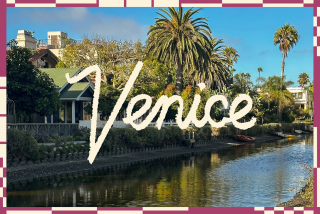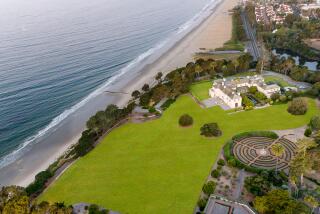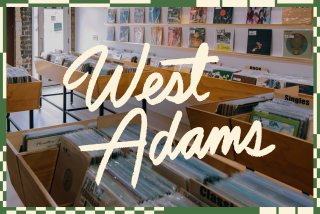Tuscan Villas Right Out of a Painting
- Share via
LUCCA, Italy — A Tuscan city hitherto unknown to my wife, Liet, and me, Lucca opened its treasures to us on a trip to Italy last summer. Surrounded by a high brick wall on top of which runs a tree-shaded walk, the heart of Lucca was full of surprises.
But our greatest find lay not in old Lucca but in the countryside within easy driving distance of the city. Between the 15th and 19th centuries, rich Lucchese bankers and merchants created magnificent summer retreats for themselves. Their grand villas and even grander gardens remain, pleasing the senses and transporting visitors into scenes usually glimpsed only in Italian Renaissance and Baroque paintings.
At first we were confounded to learn that about 300 of these villas, large and small, still exist in the arc formed by the hills behind Lucca. With only a day at our disposal, which ones should we see? A printed guide from the tourist office helped us narrow our choices to four of the most magnificent: the villas Reale, Grabau, Oliva and Torrigiano (also known as Camigliano, after the original owner).
The first three were close to one another, and the fourth was not far by car, giving us a morning and afternoon to explore them with enough time to linger over lunch at a small hillside restaurant.
First on our list was Villa Reale. We approached it by a wooded path that hid the house. Then, suddenly, it was before us, a three-story cream and terra-cotta pink structure standing against a backdrop of green hills. Mysteriously, the 30 windows of the facade were shuttered, as though the villa were asleep.
Built in the 17th century, Reale was for centuries the summer home of several distinguished families and patrons of the arts. Eventually it became the country residence of Napoleon’s oldest sister, Elisa Bonaparte Baciocchi, who, thanks to her brother’s propensity for putting his family on the thrones of Europe, became the ruler of Tuscany. She modernized the house in the then-fashionable Empire style and enlarged the grounds by incorporating the adjacent estate of the bishops. Fortunately, she left the 17th century gardens intact.
After Napoleon’s downfall, Reale passed through the hands of several aristocrats, including one known as the Mad Prince for his religious zealotry and strange behavior. He accumulated so many debts that upon his death in 1918, Villa Reale and its land had to be put up for sale, the contents of the house auctioned and many of the ancient trees cut and sold for lumber. Before the destruction was complete, Reale was bought by the Count and Countess Pecci-Blunt, who hired a prominent French landscape architect to restore the grounds.
Drawn by the villa’s reputation, American artist John Singer Sargent came here to paint in the early 20th century. The present owners, children of the count and countess, continue to welcome artists. They have also opened the gardens to the public, but the house remains off-limits.
From our vantage point at the far end of the lawn, lined on either side with paths, shrubs and tall trees, the house bespoke the power of its many owners, but the gardens on the right soon provided another picture of them. Not only did these tell of their delight in nature tamed for beauty’s sake but also of their whimsy, even their humor, with one building, as we found out, a practical joke.
After pausing in the shade of a high-walled grotto to look at a decorative fountain, we came to the formal lemon garden, with dozens of miniature trees, heavy with fruit, growing in terra-cotta pots arranged around a large pond in which swans floated. Beyond, hidden at first by foliage, was the Teatro di Verdura, a grass-carpeted semicircle backed by giant laurels, the actors represented by full-size terra-cotta figures in antique attire. Off to the side, tunnel-like avenues through bushes and trees once provided entrance and egress for audiences and a chance, perhaps, for lovers to be alone while plots unfolded on the green stage.
Led by an enthusiastic guide who spoke only Italian, but whom we seemed to understand--if only because Italian is such an emotive language--we moved through one such passage into a sunny park. Our first pause was at the ochre-colored, stuccoed bishops’ house, built around an arcaded cobblestone court. No longer lived in, it may soon become a romantic ruin for lack of maintenance--a place Sargent, were he around today, might want to paint.
Not many feet away we came upon a square two-story building, open to the elements on the ground floor and studded inside and out with cobbles and pebbles laid out in the rustic style of Renaissance garden structures. Grotesque stone faces had been set into its interior walls, turning it into an ogre’s cave.
As soon as we stepped outside, the guide, with a mischievous smile, bent down to some protruding pipes and turned the handles. Water sprayed in every direction, up from the floor, down from the lintels and across the path. One unwitting German tourist got caught between the streams and emerged doused but laughing.
Water, as we came to realize during the day, was as important as plants in the villas’ garden schemes. Used for ponds and fountains, water was taken from the streams rushing down the hills and was not wasted. The runoff from the gardens nourished the flower beds and the farms just outside the main grounds.
Our second villa, Grabau, stood next door. At our arrival, we were startled to see rolls of green Astroturf (or the Italian equivalent) unfurled side by side on the lawn, forming roller-coaster waves in front of the house. As we learned from the young guide who took us through the high-ceilinged first story, this was the work of a contemporary architect commissioned by Martini & Rossi, producer of vermouths, to celebrate and update the historic art of garden decoration. Juxtaposing the real and the unreal, the presentation succeeded.
Dating to the first half of the 16th century, Grabau, which gets its name from the German couple who bought it in 1868, first belonged to the Diodati family, powerful merchants. But as Calvinists in a Catholic culture, they abandoned their estate for their beliefs and took up residence in Geneva. Acquired eventually by the Cittadella family, the house underwent changes, becoming a prime example of neoclassical architecture.
Here, as at Reale, are lovely gardens, replete with a box-hedge theater, an oval, flower-bordered pool, shady paths that twist through tall hedges and a lawn embellished with more than 100 terra-cotta pots containing century-old lemon trees. We were much taken with the 18th century building where the trees are sheltered in winter. A gorgeous rusty red, it consists of a row of stone-framed arches with a second row of similarly framed circular windows.
Grabau’s other great decorative feature lies inside the house, an elegant drawing room with parquet floor, whose walls seemed to be draped in green, fringed silk. Close examination revealed that the decoration had been painted on the plaster. The color is still as vibrant as the day the finished room welcomed its first guests.
Then we drove a short distance to Villa Oliva, an exquisite example of Renaissance domestic architecture. The builder, Matteo Civitalli, was a sculptor by profession, a true Renaissance man. We found no one selling admission tickets at the wide-open gate, so Liet and I walked onto the grounds.
Our initial glimpse of the house startled us: Six 10-foot-tall red firecrackers (mock ones) stood upright on the lawn in vivid contrast to the dignified villa behind them, with its beautiful arcaded facade. The firecrackers had been installed as part of the Martini & Rossi celebration, and I liked them, however out of place they might have seemed. The past needs to be tweaked from time to time.
Our entry into the garden had not gone unnoticed, and we were approached by a worker who sold us admission tickets and then pointed the way to the elegant stables, where the varnished wood stalls looked almost like beds. The straw was so fresh and fluffy that it seemed the owners--only the fourth family to possess Oliva since 1500--do not keep horses.
Next to the house, red and pink begonias formed a bright carpet, and just beyond was an alcove terrace overlooking the aquamarine swimming pool, bordered with pots of geraniums. I was charmed by a mossy cascade that spilled down a low, steep slope, guarded by twin lichen-splotched terra-cotta figures riding beasts that were half horse, half fish. But the feature I liked best was the so-called coffee house, a deeply shaded “room” in the middle of a grove of trees, furnished with a large stone table, at the center of which stood a graceful stone urn.
With three villas visited by 1 p.m., we needed rest and lunch. We knew of a restaurant in a converted mill nearby, but it was closed when we arrived. So we drove up a hill and spotted another eatery, jammed with guests. Knowing that it is hard to get a really bad meal in Italy, we stopped. And lunch was indeed a delight--a ring of dark green, freshly picked arugula dressed with olive oil and vinegar, surrounding a generous serving of paper-thin slices of home-cured prosciutto. The pungent combination--consumed with bread and chilled white wine--proved delicious. My only regret was that I could not try farro, or spelt, an ancient wheat grown in the region that has recently come back into vogue. It is used in western Tuscany in soup or mixed with rice and flavored with nutmeg, pecorino cheese, grated lemon rind, salt and pepper.
Our last villa, Torrigiano, which lay half an hour away by car, was the grand finale to the day. For so theatrical a house, “finale” is just the right word. As the house came into view across an expanse of lawn, framed by the double columns of its gate, I felt like applauding.
Without doubt, the villa is a tour de force, a great ornament of the Baroque period. Not only do statues adorn the two levels of the balustrade roof, but they also fill the niches and archways of the facade, the lower part of which is fitted stone, the upper yellow stucco.
Before roaming through the gardens, we visited the interior with an English-speaking guide. Some of the chambers bore gorgeous frescoes on their ceilings and walls--depictions of the four seasons in the bedrooms, scenes from classical mythology in the drawing rooms and Roman history in the cavernous main hall. Portraits of ancestors and other valuable paintings gave us a further sense of the owners’ rich lifestyles.
The family descends from the Marquis Nicolao Santini, who was the republic of Lucca’s ambassador to the court of France’s Sun King, Louis XIV. The old ambassador, all these years after his death, is the greatest presence at the villa.
He was sunstruck by the opulence he found at the Palace of Versailles. Upon coming home, he had the villa’s rooms decorated with its frescoes, the facade done over in its present dramatic mode and the estate laid out in the formal style of Versailles’ guiding genius, the landscape architect André Le Nôtre.
A visitor to the grounds will find trees from around the world and a wide assortment of rare camellias, but there is nothing to match the sunken garden at the base of a double staircase. In its intricately patterned beds filled with bright flowers, you will see why, like the house itself, the old marquis continues to spread enchantment.
Dale M. Brown, a former editor of Time-Life Books, is a freelance writer in Virginia.
More to Read
Sign up for The Wild
We’ll help you find the best places to hike, bike and run, as well as the perfect silent spots for meditation and yoga.
You may occasionally receive promotional content from the Los Angeles Times.






